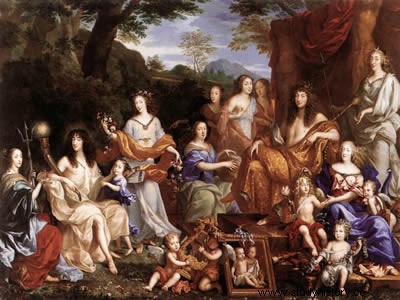(UFV-MG) The formation of the National States of Western Europe, during the Modern Period (15th to 18th centuries), although it followed its own dynamics in each country, presented similarities in its constitution process. About these similarities is incorrect affirm:
- politically, the established regime is the absolute monarchy, of which France is the classic model.
- the clergy and the nobility had their position and prestige assured by the possession of lands and were always together in the defense of their interests.
- in social terms, this period was characterized by the slow affirmation of the bourgeoisie, which was at the forefront of almost all the enterprises of the time.
- to strengthen the state, the kings adopted a set of measures to accumulate wealth and develop the national economy, called mercantilism.
- the centralization of political power in Italy was due to the great influence of the mercantile bourgeoisie of Genoa and Venice.
(FATEC-SP)
France is a monarchy. The king represents the entire nation, and each person represents nothing but a single individual before the king. Consequently, all power, all authority, resides in the hands of the king, and there must be in the kingdom only the authority which he establishes. He must be the owner, he can listen to advice, consult them, but he must decide. God who made the king will give him the necessary light, as long as he shows good intentions.
Louis XIV – Memories on the art of government .
We can characterize the monarchic absolutism put into practice in European countries during the Modern Age as:
- an alliance between an absolutist monarch and the mercantile bourgeoisie in order to dominate and exclude the power of the nobility.
- a successful alliance between the bourgeoisie and the proletariat.
- an authoritarian form of government, whose power was centralized in the hands of a person who exercised all the functions of the state.
- a synonym for the tyranny exercised by the monarch over his subjects.
- a total power concentrated in the hands of the nobility, in which judges and deputies were responsible for judging and legislating.
Indicate the alternative that correctly completes the missing words in the excerpt below.
When the 16th century arrived, the _____ dynasty resumed the strengthening of monarchical authority in the midst of the bloody religious wars that took over the country. In the government of the _____ king (1560 - 1574), several conflicts between the _____ nobility and the _____ bourgeois jeopardized the stability of monarchical power. On August 24, 1572, the night of ______ marked one of the most violent clashes with the death of 30,000 residents of the city of Paris.
- Bourbon; Louis XIV; Huguenot; Catholics; Saint Patrick.
- Orleans; Henry VI; Catholic; Calvinists; San Crispin.
- Valois; Charles IX; Catholic; Calvinists; Saint Bartholomew.
- Valois; Charles X; aristocratic; capitalists; Saint Bartholomew.
- Bourbon; Charles IX; Catholic; Calvinist; San Antonio.
Analyze the statements below about French Absolutism:
I – To put an end to conflicts of a religious nature, Henry IV signed the Edict of Nantes, an agreement that granted freedom of worship to Protestants.
II – the monarch Louis XIII came to the throne delegating broad powers to the minister Richelieu, who took measures that expanded the monarchy’s powers over the country’s nobles and merchants, also pitting France against the Habsburg dynasty during the Thirty Years’ War (1618). – 1648).
III – Prepared for the position since he was a child, King Louis XIV summarized the supremacy of the absolutist government when he said:“the State is me”. With the help of Minister Colbert, he was able to consolidate French mercantilism, stimulating bourgeois activity.
Check the alternative:
- if only alternatives I and II are correct.
- if only alternatives I and III are correct.
- if only alternatives II and III are correct.
- if all alternatives are correct.
- if none of the alternatives is correct.
See the image below.

Louis XIV's family , by Jean Nocret (1615-1672).*
In this image it is possible to perceive King Louis XIV portrayed as a mythological figure, similar to a god. The political centralization of his reign reached its peak during the Modern Age, so much so that the following sentence is attributed to him:
- “I am the State”.
- “I came, I saw and I conquered”.
- “I leave life to enter history.”
- “A man who bows down does not straighten others.”
- “It seems to me much safer to be feared than to be loved.”
Image Credit:Web Gallery of Art.
answers Question 1Letter E . The process of political unification of Italy took place only in the 19th century, during the Contemporary Period, and before that it was divided into several independent States.
question 2Letter C. The concentration of power in the hands of the monarch was the main characteristic of absolutism, as can be seen from the text of Louis XIV, a monarch who even said:“I am the State”. It was the absolute concentration of power in a single person.
question 3Letter C . It was during the reign of Charles IX that the night of Saint Bartholomew took place, in which about 30 thousand people died. This conflict was part of the great religious conflicts of the Reformation period. In the French case, only with the Edict of Nantes, of 1598, it was tried to contain the religious conflicts.
question 4Letter D .
question 5Letter A .
